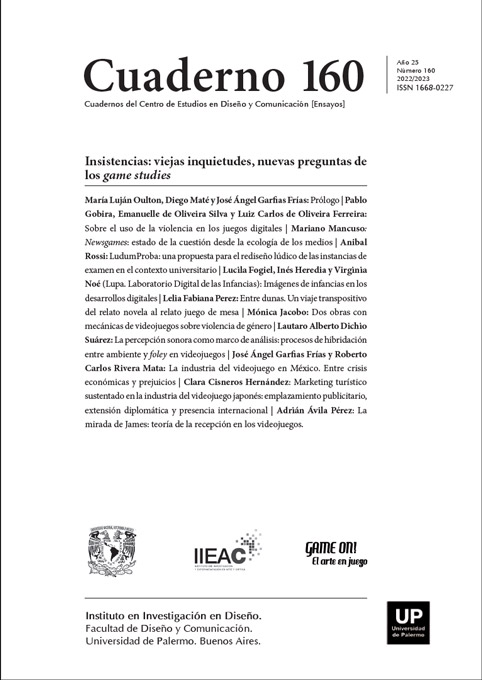La mirada de James: teoría de la recepción en los videojuegos
Abstract
Video games are media that, by their very nature, require constant interaction from players. However, there are more active users who, in addition to playing, interpret the experiences they have when doing so. This interpretation of the games is the subject of analysis in this article. Through the texts, The death of the author of Roland Barthes and the theory of reception, the importance of interpretation and over-interpretation in video games will be explained to keep old games like Silent Hill 2 relevant even over the years.
References
Atari (1982) E.T. the Extraterrestrial (Versión para Atari 2600) [Videojuego].
Bailey, S. et al (2016). The 100 Greaterst Videogames. Edge. 8-206.
Barthes, R. (1994). El susurro del lenguaje. Más allá de la palabra y la escritura. Paidos.
Bartle, R. (2003). Designing virtual worlds. New Riders Publishing
Beuglet, N. (Director), Inamura, Akihiro (Productor). (2001). The Making of Silent Hill 2 [Polícula, DVD]. Francia: Fun Tv.
Bogost, I. (2010). Persuasive Games. The Expressive Power of Videogames. The MIT Press.
Bogost, I. (2011). How to Do Things With Videogames. The MIT Press.
Culler, J. (1995). En defensa de la sobreinterpretación. En U. Eco (Comp.), Interpretación y sobreinterpretación. (pp. 127-142). Cambridge University Press.
Gadamer, H.G. (2011). Fundamentos para una teoría de la experiencia hermenéutica. En D. Rall (Comp.), En busca del texto. Teoría de la recepción literaria. UNAM. 19-29
Grodal, Torben. (2003). Stories for Eye, Ear, and Muscles: Video Games, Media, and Embodied Experiences. En Mark J. P. Wolf and Bernard Perron (Ed.) The Video Game Theory Reader. New York: Routledge. 129-55
Harris, J. (03 de noviembre de 2017). Review Roundup: Was E.T. Really the ‘Worst Game Ever?’. Video Game History Foundation. https://gamehistory.org/et-atari-reviews-worstgame-ever/
Iser, W. (1996). Las relaciones entre el texto y el autor. En E. Sullà (Ed.), Teoría de la novela. Antología de textos del siglo XX. Crítica. 248-256
Iser, W. (2011). La estructura apelativa de los textos. En D. Rall (Comp.), En busca del texto. Teoría de la recepción literaria. UNAM. 99-120
Ito, M. [@adsk4]. (31 de julio de 2020) I’ve been receiving a question about James’ gaze at the opening. But I don’t know the answer, because Takayoshi Sato [Tweet]. Twitter. https://twitter.com/adsk4/status/1289271060559302657
Ito, M. [@adsk4]. (31 de julio de 2020) To be frank, I think they think too much [Tweet]. Twitter. https://twitter.com/adsk4/status/1289329530960658432
Jauss, H. R. (2011a). Historia de la literatura como una provocación a la ciencia literaria. En D. Rall (Comp.), En busca del texto. Teoría de la recepción literaria. UNAM. 55-58
Jauss, H. R. (2011b). Cambio de paradigma en la ciencia literaria. En D. Rall (Comp.), En busca del texto. Teoría de la recepción literaria. UNAM. 59-72
Pérez Latorre, O. (2012). El lenguaje videolúdico. Análisis de la significación del videojuego. Laertes.
Perron, B. (2012). Silent Hill. The Terror Engine. The University of Michigan Press.
Sánchez Vázquez, A. (2007). De la estética de la recepción a una estética de la participación. UNAM.
Tsuboyama, M. (2001) Silent Hill 2 (Versión para Play Station 2) [Videojuego]. Kahiro.
Los autores/as que publiquen en esta revista ceden los derechos de autor y de publicación a "Cuadernos del Centro de Estudios de Diseño y Comunicación", Aceptando el registro de su trabajo bajo una licencia de atribución de Creative Commons, que permite a terceros utilizar lo publicado siempre que de el crédito pertinente a los autores y a esta revista.


